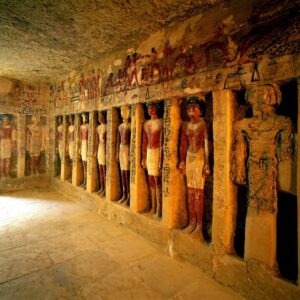In the ancient tombs of Egypt, one can not only witness the grandeur of architectural marvels but also experience a sacred space where the soul of the deceased continues its journey toward eternal life. One of the most striking features of these tombs is the line of intricately carved and vividly painted statues, placed in wall niches, with details that reflect the greatness of Egyptian civilization. So, what do these statues represent, and what can we learn from their art and beliefs through these masterpieces?
The Art of Carving and Vibrant Colors
The statues in the tombs of ancient Egypt are meticulously crafted, blending form and color in perfect harmony. Each statue is painted with vibrant colors such as red, white, gold, and blue, which hold deep meanings in Egyptian culture. These figures are not merely decorative; they embody the power and protection of the gods and serve as companions for the soul of the deceased on its journey to the afterlife.
Through the use of color and lifelike forms, the Egyptians created a sacred atmosphere where these statues appear not just as silent figures, but as protectors and guardians of the tomb. Placed in niches along the walls, they form a solemn procession, resembling a line of sentinels, ever watchful and ready to safeguard the sacred space.
The Symbolism and Hieroglyphics on the Walls
Equally important are the finely crafted hieroglyphics etched above the statues. These inscriptions are more than just text—they contain stories of the deceased’s life, beliefs, and accomplishments, offering a glimpse into the grandeur of ancient Egyptian civilization. These inscriptions also serve as a way to preserve the values and heritage that the Egyptians wanted to pass on to future generations, as well as to guide and protect the soul of the departed on its journey to the afterlife.
Every symbol and image on the walls is placed within a sacred context, creating a narrative that links the past with the future. These inscriptions are not merely historical records but are intended to help the soul of the deceased navigate the challenges of the afterlife.

Protecting the Soul and Belief in Life After Death
The significance of the statues in the Egyptian tombs lies not only in their artistic beauty but also in their spiritual role. These statues do not only protect the tomb; they are also companions and guides for the deceased’s soul on its journey to the afterlife. In the Egyptian worldview, death is not an end but a transition to an eternal life, where the soul requires protection and guidance.
This belief is clearly reflected in the depictions of gods and figures carved within the tomb. Each statue serves not only as a guardian of the tomb but also as a spiritual guide, helping the soul pass through the trials of the afterlife and reach eternal peace. Thus, the statues are more than decorative pieces; they are protectors and guides, ensuring the safety of the deceased on their journey to eternity.

Artistic Value and Spiritual Significance
The preservation of colors and the intricate carvings on these statues speak to the extraordinary skill of Egyptian artisans. These works of art are not only symbols of artistic excellence but also reflect the Egyptians’ deep connection to the afterlife and their desire to leave a lasting legacy. The statues represent a fusion of art and faith, highlighting how Egyptian art was not just for beauty but also for the soul’s protection and guidance.
This dual purpose of art as both a spiritual tool and a form of expression speaks to the sophistication of Egyptian culture, where art was not merely decorative but deeply interwoven with their beliefs about life, death, and resurrection. These statues were not just designed to decorate the tomb but to ensure the deceased’s continued existence in the next world.

Conclusion: A Timeless Journey
Visiting an ancient Egyptian tomb is not just a journey through history but a step into the deep reverence the Egyptians held for life, death, and the afterlife. The statues and inscriptions present within these tombs reflect not only the artistic mastery of the civilization but also their spiritual devotion to preserving the soul for eternity.
Exploring such sacred sites allows us to understand more about how the Egyptians viewed the afterlife and the importance they placed on ensuring that the deceased’s legacy lived on. These artistic and symbolic works are not merely historical artifacts; they are powerful reminders of the ancient Egyptians’ belief in eternity, death, and the afterlife.
